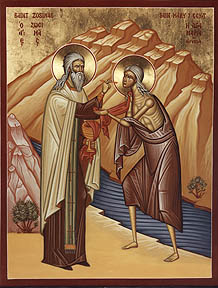Difference between revisions of "Great Canon"
Silentchapel (talk | contribs) |
m |
||
| (19 intermediate revisions by 9 users not shown) | |||
| Line 1: | Line 1: | ||
| − | The '''Great Canon of St. Andrew of Crete''' is a lengthy penitential [[canon]] composed in | + | [[Image:Andrewofcrete.jpg|right|thumb|200px|St. Andrew of Crete]] |
| + | The '''Great Canon of St. Andrew of Crete''' (also known as the ''Canon of Repentance'') is a lengthy penitential [[canon]] composed in the seventh century, which is sung during [[Great Lent]]. | ||
| − | The refrain "Have mercy | + | ==Structure and composition== |
| + | The Great Canon consists of four parts, each divided into nine odes like a regular [[canon]]. However, there are slight differences between the odes of the two compositions. In the Great Canon, there is a greater number of [[troparia]]. At the refrain "Have mercy on me, O God, have mercy on me," a full [[prostration]] is performed. Also, some of the odes have additional refrains and troparia to the author of the canon, St. [[Andrew of Crete]], or St. [[Mary of Egypt]], one of the greatest models of [[repentance]] in Christian history. | ||
| − | A basic distinguishing feature of the Great Canon is its extremely broad use of images and subjects taken from [[ | + | [[Image:Zosimas and Mary of Egypt.jpg|right|frame|Sts. Zosima and Mary of Egypt]] |
| + | |||
| + | ==Usage== | ||
| + | The Great Canon is served during the first week of the Great Lent. During [[Great Compline]] on Monday, Tuesday, Wednesday and Thursday, one portion of the Canon is sung after the [[Little Doxology]] (Greek practice) or Psalm 69 (Russian practice) is read. On Wednesday of the fifth week of the Great Lent, the Life of St. Mary of Egypt is read together with the entire Great Canon at [[Orthros]] (sometimes Thursday proper in Slavic tradition). This practice was implemented during the life of St. Andrew, who was also the author of St. Mary's [[hagiography]]. | ||
| + | |||
| + | ==Contents== | ||
| + | A basic distinguishing feature of the Great Canon is its extremely broad use of images and subjects taken both from the [[Old Testament|Old]] and [[New Testament|New]] Testaments. As the Canon progresses, the [[congregation]] encounters many biblical examples of sin and repentance. The Bible (and therefore, the Canon) speaks of some individuals in a positive light, and about others in a negative one—the penitents are expected to emulate the positive examples of sanctity and repentance, and to learn from and avoid the negative examples of sin, fallen nature and pride. However, one of the most notable aspects of the Canon is that it attempts to potray the Biblical images in a very personal way to every penitent: the Canon is written in such form that the faithful identify themselves with many people and events found in the Bible. | ||
==References== | ==References== | ||
| − | *[http://www.stjohndc.org/ | + | *[http://www.stjohndc.org/Russian/feasts/fasts/grlent/e_canon_andcrete.htm www.stjohndc.org] |
| − | ==External | + | ==External link== |
| − | *[http://www. | + | *[http://www.orthodox.net/greatlent/great-canon-fifth-week.html Great Canon of St Andrew of Crete] |
| − | [[Category: Liturgics]] | + | [[Category:Lent]] |
| + | [[Category:Liturgics]] | ||
| + | [[Category:Hymnography]] | ||
| + | [[ro:Canonul cel Mare al Sfântului Andrei Criteanul]] | ||
Latest revision as of 16:38, August 25, 2014
The Great Canon of St. Andrew of Crete (also known as the Canon of Repentance) is a lengthy penitential canon composed in the seventh century, which is sung during Great Lent.
Structure and composition
The Great Canon consists of four parts, each divided into nine odes like a regular canon. However, there are slight differences between the odes of the two compositions. In the Great Canon, there is a greater number of troparia. At the refrain "Have mercy on me, O God, have mercy on me," a full prostration is performed. Also, some of the odes have additional refrains and troparia to the author of the canon, St. Andrew of Crete, or St. Mary of Egypt, one of the greatest models of repentance in Christian history.
Usage
The Great Canon is served during the first week of the Great Lent. During Great Compline on Monday, Tuesday, Wednesday and Thursday, one portion of the Canon is sung after the Little Doxology (Greek practice) or Psalm 69 (Russian practice) is read. On Wednesday of the fifth week of the Great Lent, the Life of St. Mary of Egypt is read together with the entire Great Canon at Orthros (sometimes Thursday proper in Slavic tradition). This practice was implemented during the life of St. Andrew, who was also the author of St. Mary's hagiography.
Contents
A basic distinguishing feature of the Great Canon is its extremely broad use of images and subjects taken both from the Old and New Testaments. As the Canon progresses, the congregation encounters many biblical examples of sin and repentance. The Bible (and therefore, the Canon) speaks of some individuals in a positive light, and about others in a negative one—the penitents are expected to emulate the positive examples of sanctity and repentance, and to learn from and avoid the negative examples of sin, fallen nature and pride. However, one of the most notable aspects of the Canon is that it attempts to potray the Biblical images in a very personal way to every penitent: the Canon is written in such form that the faithful identify themselves with many people and events found in the Bible.

